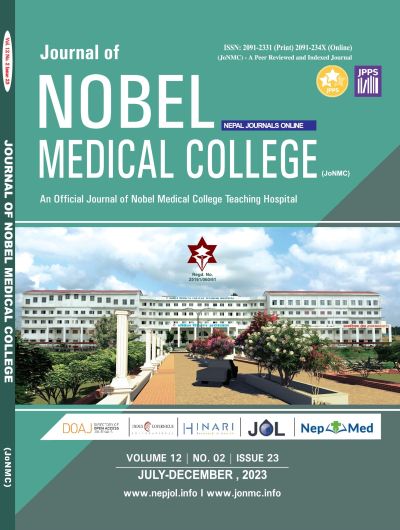Surgical Experience of Reconstruction of Distal Lower Limb Soft Tissue Defect with Reverse Sural Artery Flap with Cutaneous Pedicle
DOI:
https://doi.org/10.3126/jonmc.v12i2.61112Keywords:
Leg injuries, Reconstructive surgical procedures, Surgical flaps, Wound healingAbstract
Background: The soft tissue reconstruction of distal leg, ankle and foot is always challenging to orthopaedic surgeons. Among many available options, the reverse sural artery flap is technically easy local option to cover soft tissue defect. We aim to share our experience of reverse sural fasciocutaneous flaps for reconstruction of distal leg soft tissue defect.
Materials and Methods: An observational retrospective study was conducted on all cases that had undergone reverse sural flap surgery between February 2019 to January 2023 in orthopedic department of Nobel Medical College Teaching Hospital. The following variables were gathered for analysis: hospital stay duration, postoperative complications, etiology and duration of the wound, wound site and size, number of surgeries, associated trauma, surgery time and technical details, and final outcome in terms of flap survival.
Results: Out of 20 cases, sixteen were male and 4 were female. The mean age was 36 years. Seven cases (35%) had associated comorbidities. The most common etiology was trauma and most common sites was ankle and calcaneus (60%) followed by distal leg (35%) and foot (5%). The graft survival rate was 85%. Three cases (15%) had partial flap necrosis and one (5%) had venous congestion.
Conclusion: The reverse sural artery flap is easy, versatile and reliable technique to cover soft tissue defect in distal leg, ankle and foot.
Downloads
Downloads
Published
How to Cite
Issue
Section
License
Copyright (c) 2023 Ranjib Kumar Jha, Santosh Thapa, Asish Rajthala

This work is licensed under a Creative Commons Attribution 4.0 International License.
JoNMC applies the Creative Commons Attribution (CC BY) license to works we publish. Under this license, authors retain ownership of the copyright for their content, but they allow anyone to download, reuse, reprint, modify, distribute and/or copy the content as long as the original authors and source are cited.




